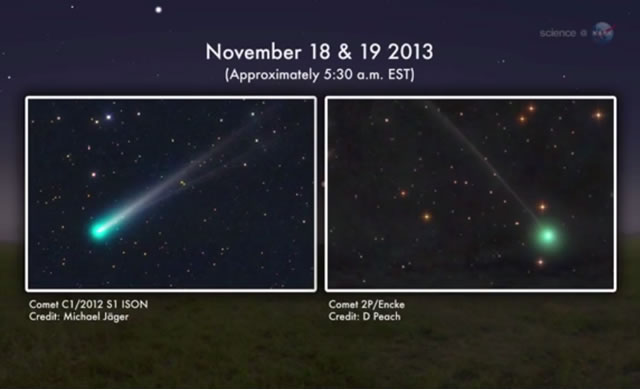
Credit: NASA
Quali sono le probabilità? Fra il 18 e il 19 novembre non una ma due comete voleranno nei pressi del pianeta Mercurio. “Questo è un caso unico”, dice Ron Vervack, astronomo presso la Johns Hopkins University Applied Physics Lab e membro del team scientifico di MESSENGER della NASA, “è un’occasione d’oro per studiare due comete che passano vicino al sole. “Il 18 novembre la Cometa Encke passerà entro 0.025 AU da Mercurio, seguita il giorno dopo dalla Cometa ISON a 0.24 UA (1 UA è la distanza tra il sole e la Terra, 150 milioni km). La sonda MESSENGER, che è in orbita intorno a Mercurio, girerà occasionalmente i suoi sensori verso le comete di passaggio per una indagine estemporanea di entrambe.
Il transito dei due corpi celesti è emozionante, dice Vervack, ma “rende il caso un po’ bizzarro. Dobbiamo correre per completare le nostre osservazioni sulla cometa Encke, per poi fare tutto da capo per la Cometa ISON. Tutto ciò accade più o meno nello stesso tempo.” MESSENGER è stata progettata per studiare Mercurio, non le comete”, ma si tratta di un veicolo spaziale in grado di farlo, grazie ad un pacchetto di strumento molto versatile”, aggiunge. Speriamo di ottenere alcuni dati. “Gli spettrometri a bordo della sonda analizzeranno la composizione chimica delle due comete , mentre le telecamere del Messenger scatteranno immagini delle atmosfere, dei getti e delle code. La Cometa ISON è già l’oggetto preferito dai media, gli astronomi la stanno seguendo dal settembre 2012 quando è stata scoperta su una traiettoria che l’avrebbe portata pericolosamente vicina al sole. Il prossimo 28 novembre 2013, giorno del Ringraziamento negli Stati Uniti, ISON passerà attraverso l’atmosfera del sole a poco più di un milione di chilometri dalla superficie ardente della nostra stella. Se la cometa di ghiaccio sopravviverà, potrebbe rivelarsi in tutta la sua bellezza ed essere visibile ad occhio nudo per gli osservatori dell’emisfero settentrionale. L’osservazione della sonda Messenger di ISON, mentre si tuffa verso l’interno dell’atmosfera solare, potrebbe fornire agli astronomi i dati di cui hanno bisogno per predire il destino della stessa cometa. La cometa Encke è meno famosa, ma non meno interessante. Per prima cosa è la fonte della pioggia di “stelle cadenti” denominate Tauridi, un quadro di lente sfere di fuoco di mezzanotte che si verifica ogni anno dai primi giorni a metà novembre. La Cometa Encke si immerge all’interno dell’orbita di Mercurio ogni 3,3 anni, quindi è regolarmente esposta all’attività solare. Nel 2007 i veicoli spaziali STEREO della NASA hanno registrato come una tempesta solare abbia potuto strappare la coda di Encke, che si è prontamente riformata.
What are the odds? On Nov. 18th and 19th not one but two comets will fly by the planet Mercury. “This is a unique coincidence,” says Ron Vervack an astronomer at the Johns Hopkins University Applied Physics Lab and a member of the science team for NASA’s MESSENGER spacecraft, “and a golden opportunity to study two comets passing close to the sun.” On Nov. 18th Comet Encke will pass within 0.025 AU of Mercury, followed a day later by Comet ISON at 0.24 AU (1 AU is the distance between the sun and Earth, 150 million km). The MESSENGER spacecraft, which is orbiting Mercury, will turn its sensors toward the passing comets for a point-blank investigation of both.
The double flyby is exciting, says Vervack, but “it makes things a little crazy. We have to rush to complete our observations of Comet Encke, then do it all over again for Comet ISON. Everything is happening at more or less the same time.” MESSENGER was designed to study Mercury, not comets, “but it is a capable spacecraft with a versatile instrument package,” he adds. “We hope to get some great data.” Onboard spectrometers will analyze the chemical makeup of the two comets while MESSENGER’s cameras snap pictures of atmospheres, jets and tails. Comet ISON is already a media favorite. Astronomers have been tracking it since Sept. 2012 when it was discovered on a trajectory that would take it perilously close to the sun. On Nov. 28th of 2013, Thanksgiving Day in the USA, Comet ISON will pass through the sun’s atmosphere little more than a million kilometers above the sun’s fiery surface. If the icy comet survives, it could emerge as a beautiful naked-eye object for observers in the northern hemisphere. MESSENGER’s glimpse of Comet ISON as it plunges inward could give astronomers the data they need to predict the comet’s fate. Comet Encke is less well known, but no less interesting. For one thing, it is the source of the Taurid meteor shower, a slow display of midnight fireballs that occurs every year in early- to mid-November. Comet Encke dips inside the orbit of Mercury every 3.3 years, so it is regularly exposed to solar activity. In 2007, NASA’s STEREO spacecraft watched as a solar storm ripped off Encke’s tail–which promptly grew back.
Source/Continue reading → NASA.gov





















